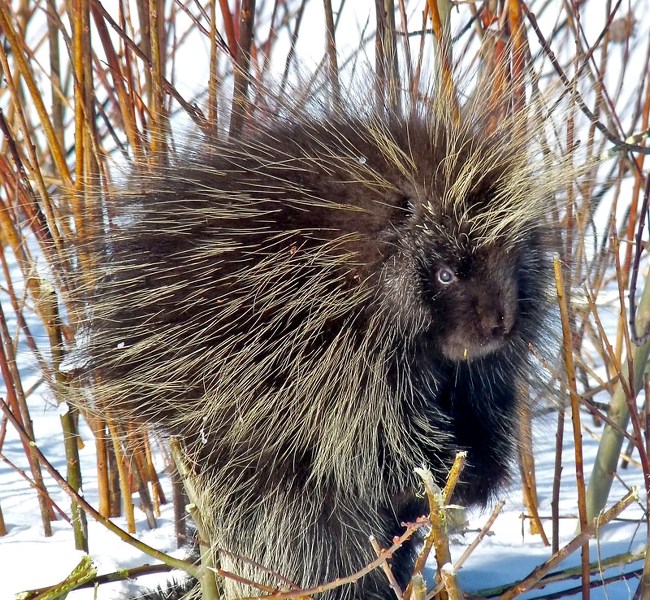Everyone knows how to find porcupines except me, it seems. I've never seen one of these spiky fur-balls alive in the wild, so I wasn't expecting much when I asked locals if there were any around town.
Everyone knows how to find porcupines except me, it seems.
I've never seen one of these spiky fur-balls alive in the wild, so I wasn't expecting much when I asked locals if there were any around town. Within minutes, I had a pile of porcupine photographs and a map leading to a possible den.
They're easy to find if you look in Riverlot 56, says Joël Gervais, a researcher at the Northern Alberta Institute of Technology. He and his friends first saw one ambling across a trail there when he was 12. "Being 12-year-old boys, we dared each other to poke it."
Porcupines are large brown-furred rodents with a blunt nose, small eyes and a short, round tail, reports Hinterland Who's Who. They're the biggest rodents in Canada after the beaver, growing up to a metre long and 30 centimetres tall.
Retired renewable resources professor Jim Butler says he's had porcupines camping under his Edmonton porch for decades. "They're not aggressive to people at all," he says, and will usually curl up in a ball until you go away.
You'll often spot porcupines snoozing or snacking high up in a tree, says Ludo Bogaert, a local naturalist. "They have a bad habit of eating the bark off of coniferous trees," he says, which is why some people dislike them. "They're actually quite cute."
You can also look for their dens, which are typically hollows in trees or under tree roots. If you see a hole surrounded by ice crystals or quills, Bogaert says, you've found a porcupine's hideout.
Search for shrubs that have been stripped of their bark along the Sturgeon, adds Gervais – that's a sure sign a porcupine has been feeding nearby. Listen carefully, and you might even hear one chewing on bark.
A passing porcupine leaves a distinct trail as well, Bogaert says: you'll see clawed footprints on either side of the deep ditch left by their tails.
Porcupines are usually pretty quiet, Butler says, but will howl like a housecat when wooing a mate.
Successful couples will stand on their hind legs, reports Hinterland Who's Who, cuff each other playfully, rub noses, hug and then get down to business. And, to answer that age-old question, the female relaxes her spines and tucks away her tail so the male doesn't get poked.
Porcupines are pretty big, Bogaert says, and are hard to miss if they're around. Butler says he knows of one that's been visiting his yard for about 10 years – it's about the size of a rain-barrel when puffed up, and he calls it "Big Daddy."
They're also pretty slow, Butler continues, which is why they're such easy prey for cars. "Their greatest enemy is certainly the automobile."
The porcupine's defences keep it safe from most everything else. Porcupines have some 30,000 quills, Hinterland Who's Who estimates, some of which are about 12 centimetres long. Each has a white or yellow shaft and a black, barbed tip that swells when moist (after being plunged into flesh, for example) making them tough and painful to pull out.
When threatened, the porcupine will turn its back to its opponent and raise its quills to become a ball of spikey death. Prod them further, Bogaert says, and they'll swat their tails. This sometimes sends loose quills flying, giving some the impression that they can "shoot" their quills.
Dog owners should keep their pets on a tight leash while in porcupine territory, Bogaert says, lest they get a mouthful of spikes. If your pet does get spiked, cut off the end of the spike to deflate it and push it through rather than pull it out.
The spines don't always work, of course – Bogaert says he's seen several dead bears at the Royal Alberta Museum who chowed down on porcupine out of desperation. "Their feet and their mouths are covered in quills."
Porcupines are novel little creatures that you don't see that often, Gervais says. They're usually pretty docile – he's seen one stop a ski race by planting its butt on the trail – and aren't a threat unless you get too close to them. "You'll probably see them once a month if you go skiing."
I guess this means I have to start skiing.
Porcupine
Name: <br />Erethizon dorsatum.<br />
Appearance: <br />Large, brown-furred rodent that's covered with spikes. <br />
Commonly seen: <br />High atop a tree, chewing on a branch, especially in Riverlot 56.<br />
Occasionally confused with: Squirrel or crow nests from a distance.<br />
Fun fact: <br />They have about 30,000 quills for defence.
Wild St. Albert
Like wildlife? So do we! Every second Wednesday the Gazette profiles a reasonably common wild creature in the St. Albert region. Birds, beasts, bugs, fish … so long as it's alive and kicking, we'll feature it. <br /><br />Got a creature you'd like to see profiled? Send your suggestions to [email protected].




